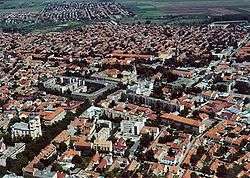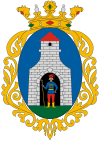Kiskunfélegyháza
| Kiskunfélegyháza | |||
|---|---|---|---|
| city | |||
|
Aerial view | |||
| |||
 Kiskunfélegyháza Location of Kiskunfélegyháza | |||
| Coordinates: 46°42′19″N 19°51′00″E / 46.70520°N 19.85005°ECoordinates: 46°42′19″N 19°51′00″E / 46.70520°N 19.85005°E | |||
| Country |
| ||
| County | Bács-Kiskun | ||
| Government | |||
| • Mayor | József Csányi (Nemzeti Fórum) | ||
| Area | |||
| • Total | 256.30 km2 (98.96 sq mi) | ||
| Highest elevation | 105 m (344 ft) | ||
| Lowest elevation | 90 m (300 ft) | ||
| Population (2011) | |||
| • Total | 30,172 | ||
| • Density | 117.7/km2 (305/sq mi) | ||
| Time zone | CET (UTC+1) | ||
| • Summer (DST) | CEST (UTC+2) | ||
| Postal code | 6100 | ||
| Area code | 76 | ||
| Website |
www | ||
Kiskunfélegyháza (Hungarian pronunciation: [ˈkiʃkunfeːlɛchaːzɒ]; German: Feulegaß) is a city in Bács-Kiskun County, Hungary.
Geography
Kiskunfélegyháza is located in the middle of the Great Hungarian Plain, 130 kilometres (81 mi) southeast from Budapest. M5 motorway, Highway 5, 451, Budapest-Cegléd-Szeged railway line and railway lines to Szolnok, Kiskunhalas and Szentes also cross the town.[1] The surrounding country is covered with vineyards, fruit gardens, and tobacco and corn fields.[2]
Name
Félegyháza means "half church" in Hungarian, while prefix Kiskun refers to the region Kiskunság ("Little Cumania").
History
Numerous Roman urns and other ancient relics have been dug up in the vicinity.
Conquering Hungarians arrived in the 9th century, adopted Christianity and settled down in the region by the 10th century.[3] The first settlements devastated by the Mongols in 1241-42, the region became uninhabited. King Béla IV invited Cuman settlers,[4] who also adopted Christianity, farming lifestyle and the Hungarian language.[3] The town was existing in 1389 when a document mentions Feledház, an earlier name for the settlement.[5] The town was ruined in 1526 by Ottoman troops and was uninhabited until the Christian troops liberated the area.[2][3][4]
Kiskunfélegyháza was reestablished by Roman Catholic Hungarian settlers[3] from Jászfényszaru and Üllés in 1743.[4] Queen Maria Theresa moved the courts and prisons for the Kiskun district to Kiskunfélegyháza in 1753 and granted town privileges also in 1774.[4][5]
Famous people
- Ferenc Móra (1879-1934), Hungarian novelist
- Béla Magyari (1949), Hungarian cosmonaut
- Sándor Petőfi (1823-1849), national poet of Hungary
- László Réczi (1947), Hungarian wrestler
- Csaba Szűcs (1965), Hungarian athlete
- Gyula Zsivótzky (1937-2007), Hungarian athlete
- Rabbi Mika M. Weiss (1913-2001), Rabbi and Holocaust Survivor
Twin towns
Kiskunfélegyháza is twinned with:
References
-
 This article incorporates text from a publication now in the public domain: Chisholm, Hugh, ed. (1911). "Kiskunfélegyháza". Encyclopædia Britannica. 15 (11th ed.). Cambridge University Press. p. 836.
This article incorporates text from a publication now in the public domain: Chisholm, Hugh, ed. (1911). "Kiskunfélegyháza". Encyclopædia Britannica. 15 (11th ed.). Cambridge University Press. p. 836.
- ↑ Magyarország autóatlasz, Dimap-Szarvas, Budapest, 2004, ISBN 963-03-7576-1
- 1 2 Chisholm 1911, p. 836.
- 1 2 3 4 Károly Kocsis (DSc, University of Miskolc) – Zsolt Bottlik (PhD, Budapest University) – Patrik Tátrai: Etnikai térfolyamatok a Kárpát-medence határon túli régióiban, Magyar Tudományos Akadémia (Hungarian Academy of Sciences) – Földrajtudományi Kutatóintézet (Academy of Geographical Studies); Budapest; 2006.; ISBN 963-9545-10-4, CD Atlas
- 1 2 3 4 Antal Papp: Magyarország (Hungary), Panoráma, Budapest, 1982, ISBN 963 243 241 X, p. 860, pp. 405-407
- 1 2 "Hungary, Kiskunfelegyhaza". Retrieved 20 June 2013.
External links
- (Hungarian) Kiskunfélegyháza website



